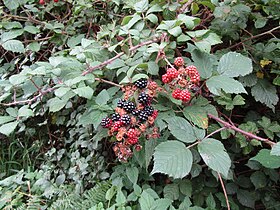Bramble
Rubus, commonly known as brambles is a large and diverse genus of flowering plants in the rose family, Rosaceae, subfamily Rosoideae, with over 1,350 species.[3][4][5]
| Bramble Temporal range:
| |
|---|---|

| |
| Rubus bush with ripe and unripe blackberries | |
| Scientific classification | |
| Kingdom: | Plantae |
| Clade: | Tracheophytes |
| Clade: | Angiosperms |
| Clade: | Eudicots |
| Clade: | Rosids |
| Order: | Rosales |
| Family: | Rosaceae |
| Subfamily: | Rosoideae |
| Tribe: | Rubeae |
| Genus: | Rubus L.[1] |
| Type species | |
| Rubus fruticosus L.[2]
| |
| Synonyms[3] | |
|
List
| |
Raspberries, blackberries, and dewberries are common. Bristleberries are endemic to North America. Most of these plants have woody stems with prickles like roses; spines, bristles. Gland-tipped hairs are also common. The term "cane fruit" or "cane berry" applies to any Rubus species or hybrid. They are commonly grown with supports such as wires or canes This includes hybrids such as loganberry, boysenberry, marionberry and tayberry.[6] The stems of these plants are referred to as canes.
Description
changeBramble bushes typically grow as shrubs (though a few are herbaceous), with their stems being typically covered in sharp prickles.[7] They grow long, arching shoots that readily form roots when they contact with soil. [8] New shoots grow in the spring from this rootstock.[9] The leaves are either evergreen or deciduous, and simple, lobed, or compound.[7] The shoots typically do not flower or set fruit until the second year of growth (i.e. they are biennial).[9] The rootstock is perennial.[10] Most species are hermaphrodites with male and female parts being present on the same flower.[7] Bramble fruits are aggregate fruits formed from smaller units called drupelets.[9]
Around 60-70% of species of Rubus are polyploid (having more than two pairs of each chromosome), with species ranging in ploidy from diploid (2x, with 14 chromosomes[11]) to tetradecaploid (14x).[12]
References
change- ↑ "Rubus". Germplasm Resources Information Network (GRIN). Agricultural Research Service (ARS), United States Department of Agriculture (USDA). Retrieved 2010-06-27.
- ↑ "Rubus L.". Tropicos. Missouri Botanical Garden. Retrieved 2010-06-27.
- ↑ 3.0 3.1 "Rubus L." Plants of the World Online. Board of Trustees of the Royal Botanic Gardens, Kew. 2021. Retrieved 4 September 2021.
- ↑ Template:EFloras
- ↑ "the definition of bramble". Dictionary.com. Retrieved 2016-02-15.
- ↑ Klein, Carol (2009). Grow your own fruit. United Kingdom: Mitchell Beazley. pp. 224. ISBN 978-1-84533-434-5.
- ↑ 7.0 7.1 7.2 "Rubus - Trees and Shrubs Online". www.treesandshrubsonline.org. Retrieved 2023-09-27.
- ↑ "Brambles and other woody weeds /RHS Gardening". www.rhs.org.uk. Retrieved 2016-02-15.
- ↑ 9.0 9.1 9.2 "Bramble or blackberry | Woodlands.co.uk". www.woodlands.co.uk. Retrieved 2016-02-15.
- ↑ "Blackberry Planting, Spacing, and Trellising". Alabama Cooperative Extension System. Retrieved 2023-09-27.
- ↑ "Rubus all species | GDR". www.rosaceae.org. Retrieved 2023-09-27.
- ↑ "Small genomes in tetraploid Rubus L. (Rosaceae) from New Zealand and southern South America". www.ars.usda.gov. Retrieved 2023-09-27.